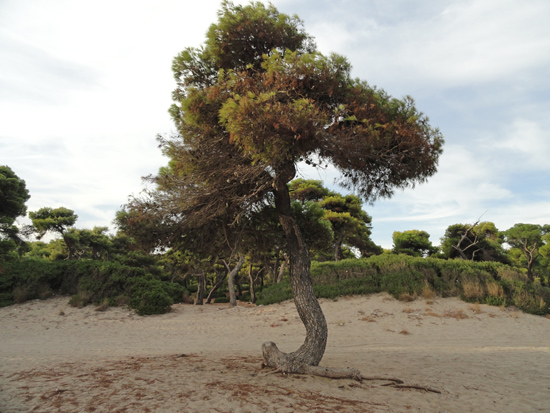
Here I am, back in Greece. While the Republicans hold the nation hostage back home, I’m sipping ouzo and enjoying the last warm days of a summer that keeps extending itself further and further towards Christmas.
The day after I got here, Stavros and I drove down to our favorite beach in Schinias, almost the only people on the beach. While bobbing around in the surf, a stray dog emerged from the pine trees bordering the beach, causing a bit of panic as we thought the pooch was going to snarf our picnic items, but instead he sauntered slowly down to the water, wet its paws, one at a time, looked us over, and then returned to the pines.
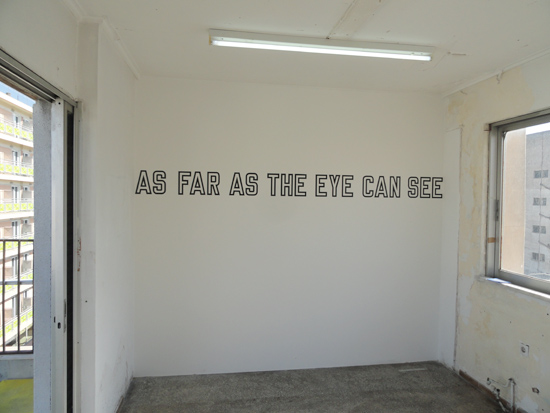
There was a very interesting series of exhibits in Athens last week, ReMap 4. Participating artists created temporary installations in abandoned buildings, apartment units, and other public and private spaces in the Kerameikos-Metaxourgeio neighborhoods. Gagosian and Peres Projects hosted installations, converting their spaces, like neocolonialist ambassadors of culture, into temporary New York-like sleek gallery spaces. James Turrell’s light installation was set in a lovely old building, but any trace of place was eliminated by converting the room into a dark characterless cube, the single window in the room emanating slightly changing blurry colors from a frosted glass plate. Turrell claims that this work is about space and the light that inhabits it, but it’s not. It’s about TV, only blurry.
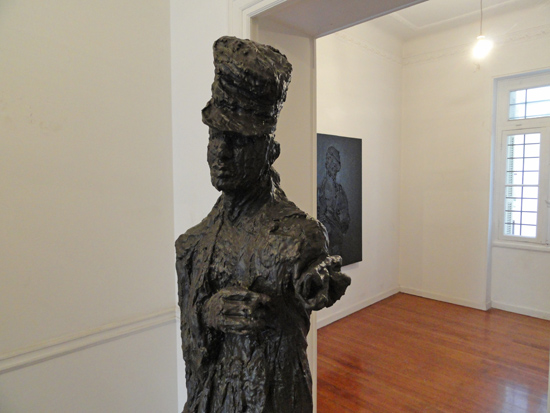
In Wyatt Kahn and Wesley Martin Berg’s installations in a 19th century apartment building, the space was left untouched, the crumbling details of the building–wall trim, mosaic floors, lovely old doors and windows–creating a visually charged domestic backdrop for their enigmatic and intriguing forms. Kahn makes polyagonal canvases that are bolted together into single rectangular picture planes. Berg presented sculptures and paintings based on a single hobo-like figure, each work formed from gloppy black neo-expressionist strokes. The confident messiness of their gestures seemed well-suited to the dilapidated beauty of the building.
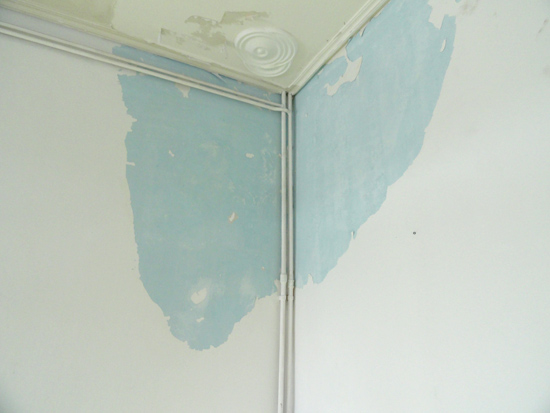
In a newer, but also crumbling sort of utilitarian post-WWII apartment building, an artist created intriguing drippy brightly colored flat rectangles and circular forms on the stairway walls and hallway. I don’t know who did them, but the aesthetic seemed borne of the site and situation, just the type of art that belonged on those walls.
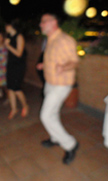 After ReMap, Stavros and I went to his cousin’s wedding. My first big fat Greek wedding! The service was very wordy, the priest addressing the bride and groom for what seemed like an eternity, loopy fabric rings placed on their heads at one point, lots of hand and ring kissing, the couple circling around the priest… At the reception after, I was forced to do that Greek dance that you see in the movies. I had studied the foot movements for several minutes prior, sure that at any moment I was going to be pushed onto the dance floor, and thought I discerned a footstep pattern and was already dancing in my head, but as soon as I was up there, I’m sure I looked like an idiot. But what the heck, it was really fun. I even discoed and ponied with Stavros’ mom and sister. Stavros’ mom asked him if I were available as prospective husband material for his sister. Not eager to tell his parents that I’m prospective husband material for their son, Stavros sidestepped the question in a way that led to further delightfully silly complications worthy of a Rock Hudson and Doris Day script.
After ReMap, Stavros and I went to his cousin’s wedding. My first big fat Greek wedding! The service was very wordy, the priest addressing the bride and groom for what seemed like an eternity, loopy fabric rings placed on their heads at one point, lots of hand and ring kissing, the couple circling around the priest… At the reception after, I was forced to do that Greek dance that you see in the movies. I had studied the foot movements for several minutes prior, sure that at any moment I was going to be pushed onto the dance floor, and thought I discerned a footstep pattern and was already dancing in my head, but as soon as I was up there, I’m sure I looked like an idiot. But what the heck, it was really fun. I even discoed and ponied with Stavros’ mom and sister. Stavros’ mom asked him if I were available as prospective husband material for his sister. Not eager to tell his parents that I’m prospective husband material for their son, Stavros sidestepped the question in a way that led to further delightfully silly complications worthy of a Rock Hudson and Doris Day script.
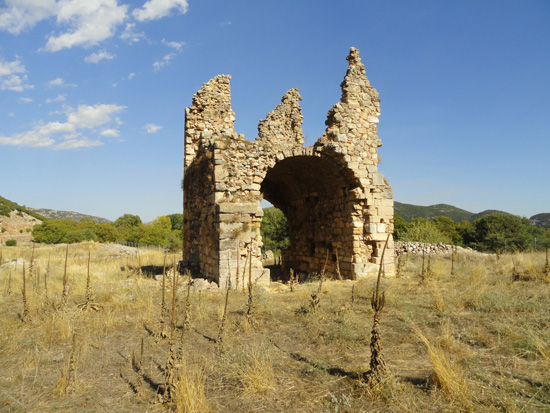
The day after we drove to the Peloponnesos, to the mountains northeast of Corinth, after a little dip in the sea at Kiato. We visited the Zaraka Monastery ruins, built in 1225 by the Cistercians, one of the few examples of western gothic architecture in Greece. Winding through the lovely wine country, we made our way to Lake Stymphalia. This was the site of one of Hercules’ Labors, the slaying of the Stymphalian birds, or “the giant chickens” as Stavros calls them. These were man-eating birds with bronze beaks and poisonous metal feathers, pets of Ares, the god of war.
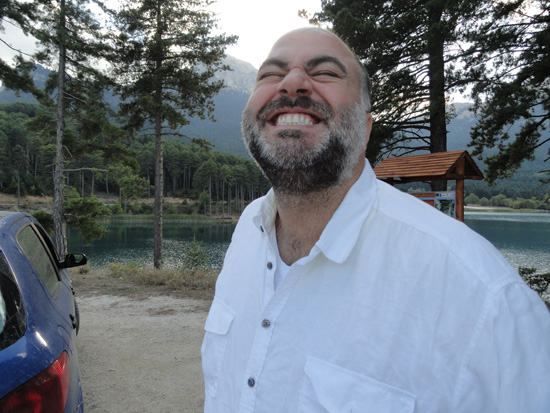
Driving through the mountains and dense pine forests, past the ruins of ancient Feneos, we visited an artificial lake, Lake Doxa, and to a monastery in the hills above, Agios Georgios. The monk-in-training invited us in to see the really wonderful 18th century byzantine paintings in the church, and then to come up for some “candy,” as Stavros translated. The monks make a rose jelly that our trainee offered us samples of, totally yummy, so we bought a few bottles and enjoyed his delightful company and the fabulous view from his terrace overlooking the valley and lake below.
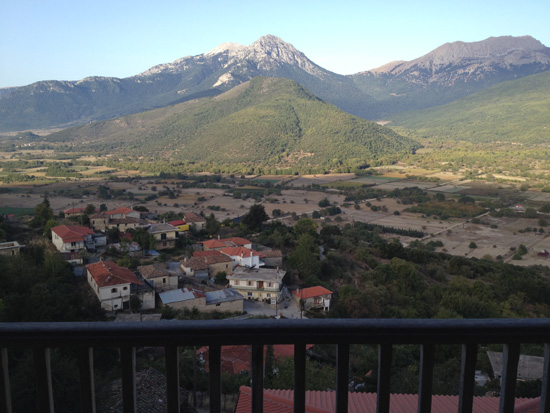
From the monastery we continued our drive through the hills to the picturesque little village of Goura, named after a hero of the Greek War of Independence, whose house still stands there. We checked into a hotel built of stone, peaked heavy-beamed ceilings, wood paneling, our room overlooking the fertile plain below and mountains beyond. The only other tourists in town settled in the room right next to ours and generated exceptionally loud lovemaking sounds twice, the first time for about a minute late that night, the second time the next morning for a quick 5 seconds, a shrill “eee… eeeee… EEEEEEE!” The same couple also sat directly next to us at the only restaurant open this late in the season, our shared intimate squeaks and squeals acknowledged by a slight nod to each other as we checked out and headed back to Athens.
